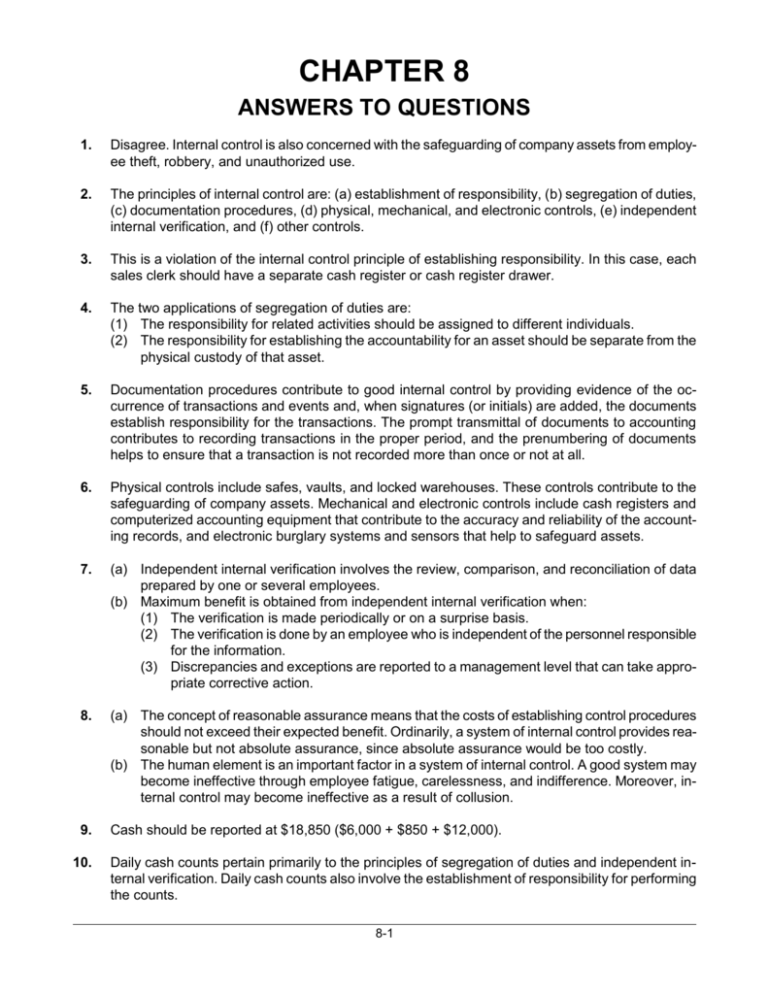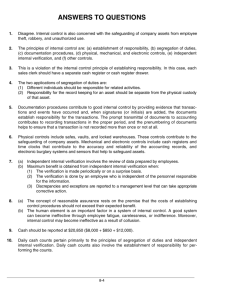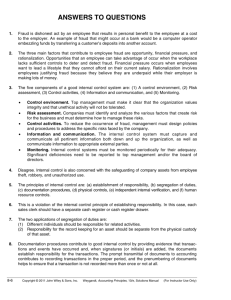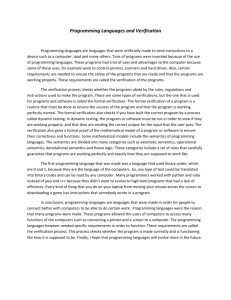ch08
advertisement

CHAPTER 8 ANSWERS TO QUESTIONS 1. Disagree. Internal control is also concerned with the safeguarding of company assets from employee theft, robbery, and unauthorized use. 2. The principles of internal control are: (a) establishment of responsibility, (b) segregation of duties, (c) documentation procedures, (d) physical, mechanical, and electronic controls, (e) independent internal verification, and (f) other controls. 3. This is a violation of the internal control principle of establishing responsibility. In this case, each sales clerk should have a separate cash register or cash register drawer. 4. The two applications of segregation of duties are: (1) The responsibility for related activities should be assigned to different individuals. (2) The responsibility for establishing the accountability for an asset should be separate from the physical custody of that asset. 5. Documentation procedures contribute to good internal control by providing evidence of the occurrence of transactions and events and, when signatures (or initials) are added, the documents establish responsibility for the transactions. The prompt transmittal of documents to accounting contributes to recording transactions in the proper period, and the prenumbering of documents helps to ensure that a transaction is not recorded more than once or not at all. 6. Physical controls include safes, vaults, and locked warehouses. These controls contribute to the safeguarding of company assets. Mechanical and electronic controls include cash registers and computerized accounting equipment that contribute to the accuracy and reliability of the accounting records, and electronic burglary systems and sensors that help to safeguard assets. 7. (a) Independent internal verification involves the review, comparison, and reconciliation of data prepared by one or several employees. (b) Maximum benefit is obtained from independent internal verification when: (1) The verification is made periodically or on a surprise basis. (2) The verification is done by an employee who is independent of the personnel responsible for the information. (3) Discrepancies and exceptions are reported to a management level that can take appropriate corrective action. 8. (a) The concept of reasonable assurance means that the costs of establishing control procedures should not exceed their expected benefit. Ordinarily, a system of internal control provides reasonable but not absolute assurance, since absolute assurance would be too costly. (b) The human element is an important factor in a system of internal control. A good system may become ineffective through employee fatigue, carelessness, and indifference. Moreover, internal control may become ineffective as a result of collusion. 9. Cash should be reported at $18,850 ($6,000 + $850 + $12,000). 10. Daily cash counts pertain primarily to the principles of segregation of duties and independent internal verification. Daily cash counts also involve the establishment of responsibility for performing the counts. 8-1 Questions Chapter 8 (Continued) 11. Cash registers are readily visible to the customer. Thus, they prevent the sales clerk from ringing up a lower amount and pocketing the difference. In addition, the customer receives an itemized receipt, and the cash register tape is locked into the register for further verification. 12. Two mail clerks contribute to a more accurate listing of mail receipts and to the endorsement of all checks “For Deposit Only.” In addition, two clerks reduce the likelihood of mail receipts being diverted to personal use. 13. Payment by check contributes to effective internal control over cash disbursements. However, effective control is also possible when small payments are made from petty cash. 14. The procedure and related principle are: Procedure Principle (1) Treasurer signs checks. (2) Checks imprinted by a checkwriter. (3) Comparing check with approved invoice before signing. Establishment of responsibility. Physical, mechanical, and electronic controls. Independent internal verification. 15. Physical, mechanical, and electronic controls apply to cash disbursements when: (a) blank checks are stored in a safe, and access to the safe is restricted to authorized personnel, and (b) a checkwriter is used to imprint amounts on checks. Other controls apply when the approved invoice is stamped PAID after payment. 16. (a) A voucher system is an extensive network of approvals by authorized individuals acting independently to ensure that all disbursements by check are proper. (b) The internal control principles applicable to a voucher system are: (1) establishment of responsibility, (2) segregation of duties, and (3) independent internal verification. 17. Electronic funds transfer is a cash disbursement system that uses wire, telephone, or computers to transfer cash from one location to another. 18. The activities in a petty cash system and the related principles are: (a) (1) Establishing the fund. (2) Making payment from the fund. (3) Replenishing the fund. Establishment of responsibility for custody of fund. Documentation procedures because the custodian must use a prenumbered petty cash receipt. Independent internal verification because the request for replenishment must be approved before the check is written. (b) Journal entries are required for a petty cash fund when it is established and replenished. Entries are also required when the size of the fund is increased or decreased. 19. A bank contributes significantly to internal control over cash because it: (1) safeguards cash on deposit, (2) minimizes the amount of cash that must be kept on hand, and (3) provides a double record of all bank transactions. 8-2 Questions Chapter 8 (Continued) 20. The lack of agreement between the balances may be due to either: (1) Time lags—a check written in July does not clear the bank until August. (2) Errors—a check for $110 is recorded by the depositor at $101. 21. The four steps are: (1) determine deposits in transit, (2) determine outstanding checks, (3) discover any errors made, and (4) trace bank memoranda. 22. (a) An NSF check occurs when the checkwriter’s bank balance is less than the amount of the check. (b) In a bank reconciliation, a customer’s NSF check is deducted from the balance per books. (c) An NSF check results in an adjusting entry in the company’s books, as a debit to Accounts Receivable and a credit to Cash. 23. (a) Cash equivalents are highly liquid investments that may be converted to a specific amount of cash with maturities of three months or less when purchased. Cash equivalents may be reported with cash in the current asset section of the balance sheet. (b) Cash restricted for a special purpose should be reported separately as a current or noncurrent asset depending on when the cash is expected to be used. 8-3




